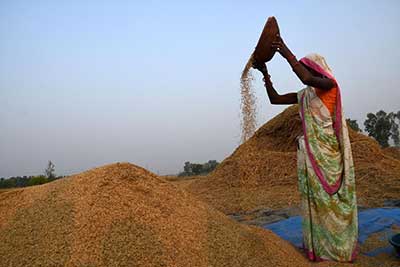Date: 01/02/2023
Relevance: GS-3: Transport and Marketing of Agricultural Produce and Issues and Related Constraints; E-technology in the aid of farmers
Key Phrases: Performance-linked Budgeting-size or Assets, Equity Grants (EGs), Credit Guarantee Schemes, Improving operating effectiveness of dairy FPCs, Companies Act 2013, Welfare Model of ‘Collectivization.
Why in News?
- FPC's continue to suffer from marketing challenges, compelling them to operate on a thin margin. As a recourse, they merely function as an intermediary between the suppliers and member farmers, like other farmer organisations.
- Against this backdrop, Budget 2023-24 is critical to boosting farmer enterprises following a segmented performance-linked budgeting-size or assets, member base, paid-up and social capital.
Fund Mobilization for FPCs:
- The mobilization of equity grants (EGs) and credit guarantee schemes (CGSs) or produce funds by apex institutions (SFAC and NABARD) seeks to strengthen FPCs’ health and operations.
- The Budget provision is directly linked with these funds.
Status of Fund Dispersal to FPCs:
- A cumulative ₹54.70 crore EG had been disbursed to 869 FPCs benefiting about seven lakh member-producers, while a cumulative ₹84.13 crore CGS helped 282 FPCs having about 5.2 lakh member-producers.
- CGS sanctioned has registered a CAGR of 41 percent from 2014-15 to 2021-22, while the EG sanctioned observed a CAGR of 28 percent during the corresponding period.
- EG and CGS-sanctioned cases are skewed towards southern and western States, with farmers who benefited from the CGS registering a CAGR of 64 percent.
- Moreover, a two-period moving average shows a declining trend of EG and CGS.
FPC as viable ‘new age’ options to address farmers' distress:
- FPCs, introduced in 2000, to address the challenges faced by the farmers while maintaining India’s present welfare equilibrium.
- FPCs function under the Companies Act of 2013 operating on the long-standing welfare model of ‘collectivization’, wherein shareholding farmers pool resources for better market linkages.
- Unlike older models, FPCs are meant to prioritize business and are assessed by the profits they earn.
What are the benefits of FPC?
- While FPCs may not appear lucrative in the short-term, they offer a chance to own a piece of business led by a professional team that constantly mentors its farmers on good cropping practices, creates market opportunities through e-commerce platforms and client networks, offers support for product branding and ensures transparency of profit distribution.
- This promise of a profit-oriented agri-business maximizing value for its small and marginal farmer shareholders has gained immense popularity.
- It has been over two decades since FPCs came into existence as a hybrid legal entity by blending the altruistic cooperation principles and enterprising spirit of a limited company.
Need for Performance-linked budgeting for FPCs:
- Improving operating effectiveness of dairy FPCs:
- Among the top 20 FPCs, 60 per cent of the FPOs are in dairy businesses; hence, they draw more attention from donors and funding agencies.
- The dairy FPCs ensure the regular engagement of their members in selling liquid milk to dairy processing units.
- Dairy FPCs have commodified the liquid milk business to stabilise the market prices and reduce the production risks for their members.
- Commoditisation offers products at different price points or different products at similar price points — for example, the price difference between AMUL and non-AMUL or State-owned milk and milk product brands.
- Dairy FPCs seek to integrate their value chains by providing cattle feed, veterinary and AI services, credit, insurance facilities for cattle purchases, etc.
- Procuring processing and bulk milk-chilling units and refrigerated vans can further improve the operating effectiveness of dairy FPCs.
- Budgeting for Horticulture sector:
- FPCs dealing with horticulture produce, especially fruits and vegetables, could attract funds if they focus on providing good quality certified seeds and planting materials, fertilisers and pesticides, technology appropriate for smallholders, and crop advisories to ensure good quality production and regular supply.
- They should develop production clusters where production intensity is higher. It will be logistically feasible for buyers to procure commodities from a production hub or aggregation centre.
- Budgeting for agriculture sector:
- Agriculture FPCs deal with inputs business where profit margins are low, say, 3-5 per cent. Thus, need to shift from input to output business.
- FPCs must deal with multiple commodities to increase their turnover and profitability, by enhancing member economic participation.
- They need to clean, grade, or assort the produce before they sell to buyers to realise a 10-15 per cent increase in sales prices.
Way Forward:
- The curation of potential buyer databases, business and market planning, demand assessment, traceability adoption along the supply chain, sustainable practices for product differentiation, and labelling can induce profitability for agri FPCs.
- While policymakers should take stock of the utilisation of EG and CGS by categories of FPCs, their repayment and credit behaviour, scale for grading of FPCs may be revised considering ESG dimensions.
- A “one-size-fits-all” Budget cannot firm up FPC business metrics and the Budget allocation may be linked to a balanced score card of FPCs which have been transacting and transcending through the life-cycle stages.
Source: Hindu BL
Mains Question:
Q. FPC's continue to suffer from marketing challenges, compelling them to operate on a thin margin. As a recourse, they merely function as an intermediary between the suppliers and member farmers, like other farmer organisations. Examine. (150 words)






















